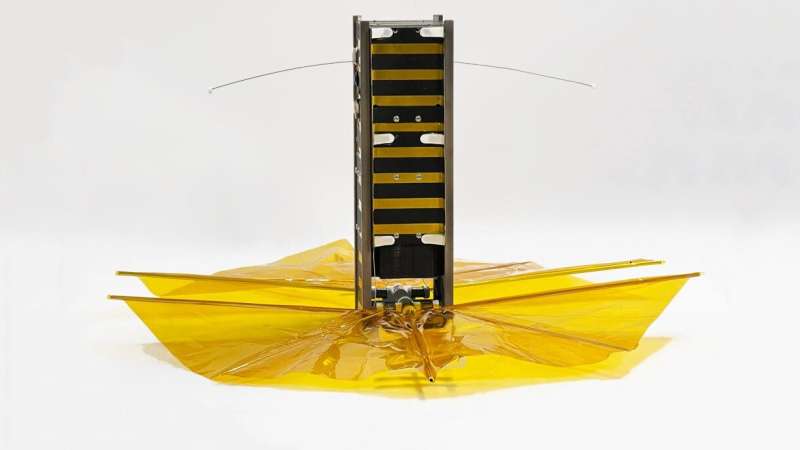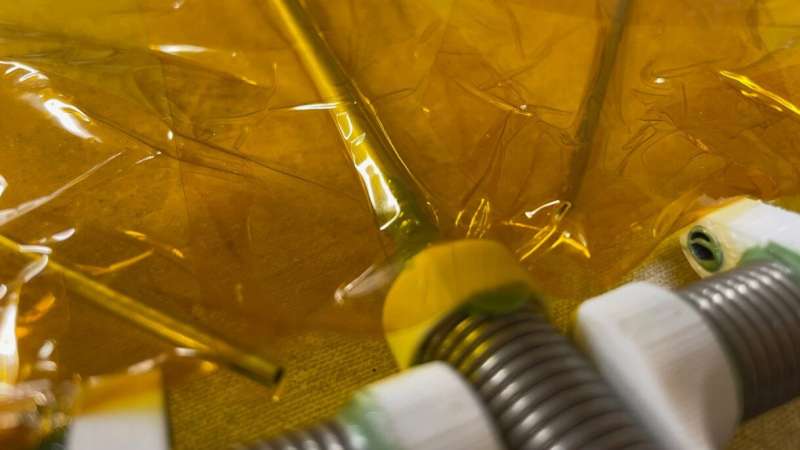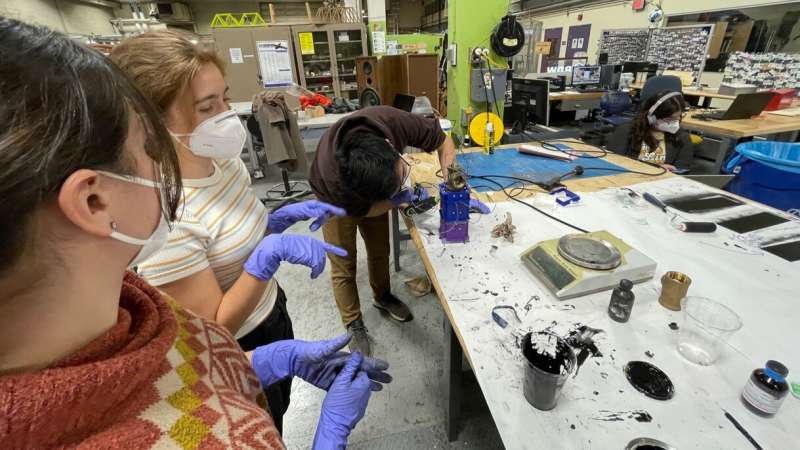This article has been reviewed according to Science X's editorial process and policies. Editors have highlighted the following attributes while ensuring the content's credibility:
fact-checked
trusted source
proofread
Satellite powered by 48 AA batteries and a $20 microprocessor shows a low-cost way to reduce space junk

Common sense suggests that space missions can only happen with multimillion-dollar budgets, materials built to withstand the unforgiving conditions beyond Earth's atmosphere, and as a result of work done by highly trained specialists.
But a team of engineering students from Brown University has turned that assumption on its head.
They built a satellite on a shoestring budget and using off-the-shelf supplies available at most hardware stores. They even sent the satellite—which is powered by 48 Energizer AA batteries and a $20 microprocessor popular with robot hobbyists—into space about 10 months ago, hitching a ride on Elon Musk's SpaceX rocket.
Now, a new analysis of data from Air Force Space Command shows that the satellite not only successfully operated, but could have far-ranging impacts on efforts to cut down on the growing problem of space debris, which poses a potential danger to all current and future space vehicles.
According to NASA, there are now more than 27,000 pieces of what it calls orbital debris or space junk being tracked by the Department of Defense's global Space Surveillance Network. Orbital debris ranges from any human-made object in Earth's orbit that no longer serves a useful function, like nonfunctional spacecraft, abandoned launch-stage vehicles, mission-related debris and fragmentation debris. It also includes defunct satellites that remain in orbit sometimes decades after their mission is complete.
That's a problem, given that most satellites remain in orbit for an average of 25 years or more, said Rick Fleeter, an adjunct associate professor of engineering at Brown. So when his students got a once-in-a-lifetime chance to design and build their own satellite to be launched into space, they decided to engineer a potential solution.
The students added a 3D-printed drag sail made from Kapton polyimide film to the bread-loaf-sized cube satellite they built. Upon deployment at about 520 kilometers—well above the orbit of the International Space Station—the sail popped open like an umbrella and is helping to push the satellite back down to Earth sooner, according to initial data. In fact, the satellite is well below the other small devices that deployed with it. In early March, for instance, the satellite was at about 470 kilometers above the Earth while the other objects were still in orbit at about 500 kilometers or more.

"You can see in the tracking data that we're visibly below everybody else and accelerating away from them," Fleeter said. "You can see that our satellite is already descending toward reentry, whereas the others are still in a nice circular orbit higher up."
The data suggest that the student satellite, called SBUDNIC, will be out of orbit within five years versus the estimated 25 to 27 years the students calculated for it without the drag device.
Fleeter and the Brown students believe that their initial analysis of the publicly available tracking data serves as a proof of concept that this type of sail can be part of an effort to reduce the number of space debris in orbit around Earth. They hope similar sails can be added to other same-sized devices or scaled up to larger projects in the future.
"The theory and physics of how this works has been pretty well accepted," Fleeter said. "What this mission showed was more about how you realize it—how you build a mechanism that does that, and how you do it so it's lightweight, small and affordable."
The project is a result of a collaboration between researchers at Brown's School of Engineering and the National Research Council of Italy. It is also supported by D-Orbit, AMSAT-Italy, La Sapienza-University of Rome and the NASA Rhode Island Space Grant. The name of the satellite is a play on Sputnik, the first satellite to orbit the Earth, and is also an acronym for the project participants.
This is the second small satellite designed and built by Brown students that's been sent into orbit in recent years. The previous satellite, EQUiSat, did 14,000 loops around the Earth before ending its mission and burning up upon re-entering the atmosphere at the end of 2020.
SBUDNIC, however, is believed to be the first of its kind that was sent into orbit made almost exclusively from materials not designed for use in space and at such an astronomically low-cost when compared to other objects in orbit. The total cost of the student-designed cube satellite was about $10,000.
"The large complex space missions we hear about in the news are amazing and inspiring, but they also send a message that space is only for those types of specialized initiatives," Fleeter said. "Here, we're opening up that possibility to more people… We're not breaking down all the barriers, but you have to start somewhere."

Engineered by students at Brown
The satellite was designed and built in one year by a group of about 40 students—about half from Brown's School of Engineering with others from fields as diverse as economics, international relations and sculpture. It started in the course ENGN 1760: Design of Space Systems, which Fleeter taught in Spring 2021.
Italian aerospace company D-Orbit approached with an opening for a satellite on the SpaceX Falcon 9 rocket that would launch in one year. Fleeter turned to his students, who had just listened to their first seminars on space systems design and presented them the opportunity.
From there, the race was on.
The students began by conceptualizing and designing the individual subsystems of the satellite, often working with industry advisors who provided feedback and engineering guidance on the feasibility of their proposals. Students then put their plans into action, managing the technical aspects of the satellite along with coordinating the administrative pieces. The continual prototyping, testing and improving required amounted to a herculean effort from students in terms of hours and brain power.
"The Brown Design Workshop is very quiet at 4 a.m., and I've been there during that time more times than I can count," said Marco Cross, who graduated from Brown last year with a master's degree in biomedical engineering and served as chief engineer for SBUDNIC.
Students purchased materials they needed at local stores and online retail websites. They often had to engineer nifty workarounds to their materials so they could survive in space. The approach often meant coming up with test apparatuses that replicated specific environmental conditions of space, like the high vibration from the rocket launch, Cross said. For instance, the team used reptile heating lamps in a vacuum chamber to test the thermal shield they created to protect the satellite's electronics from the sun.
To be cleared for launch, the satellite had to pass qualification tests and meet strict rules and regulations that SpaceX and NASA follow. "It is a zero-failure-tolerated environment," Cross said. "The team never wavered."

The students got the green light after a series of vacuum, thermal and vibration tests. A group then traveled to Cape Canaveral in Florida to deliver SBUDNIC so it could be inserted into D-Orbit's larger carrier satellite, which was then put onto the SpaceX rocket.
Students said the project helped them think of themselves as creators and innovators, and that experience ingrained in them lessons they'll use well into the future.
"I went on to use what I learned on this program to intern at Lockheed Martin Space," said Selia Jindal, a senior at Brown and one of the project leads. "This project truly helped shape how I see the world and has been extremely influential in shaping my undergrad experience. This sentiment is not unique to me. Many team members, like me, came into SBUDNIC with no prior experience in the space industry and left pursuing paths in the field. We have SBUDNIC alumni across the industry—from pursuing Ph.D.s to engineering at SpaceX."
Along with presenting their findings at conferences and submitting their data to a publication, the SBUDNIC team is currently planning a series of presentations in schools throughout Rhode Island. They hope to inspire future innovators and make high school students more aware of the opportunities that exist for them in space engineering and design.
Provided by Brown University




















